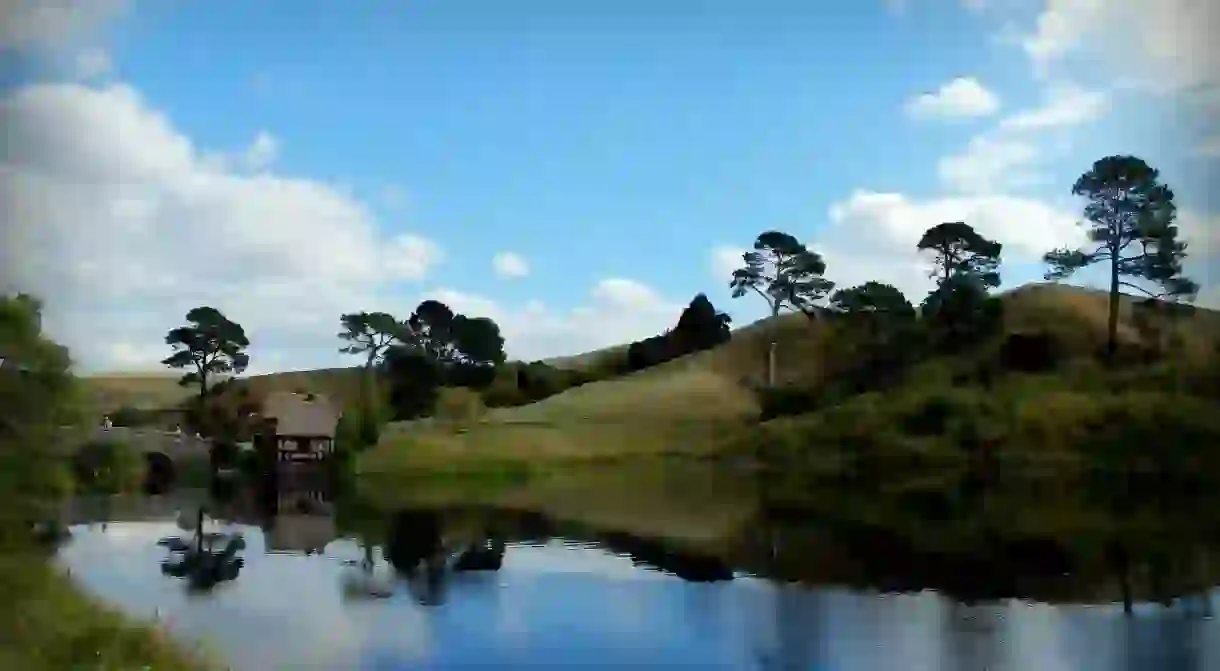8 New Zealand Locations Filmed in The Hobbit Trilogy

We think it’s pretty safe to say that every man and his dog knows that New Zealand, for all intents and purposes, is Middle-Earth. It’s varied, beautiful, rugged and simply breathtaking scenery is as close to the land Tolkien must have imagined as is possible. Here is our guide to visiting the locations from Peter Jackson’s second trilogy, The Hobbit.
Matamata
This is perhaps the most famous location from both The Hobbit and The Lord of the Rings. Originally, in Peter Jackson’s first Oscar-winning trilogy, almost the entire set – most of the facades of the hobbit holes and a lot of the surrounding buildings – were actually constructed out of blocks of polystyrene. The set was initially allowed to stay for as long as it naturally stood.

With the success of the films it became a massive tourist attraction and brought in a lot of money for the surrounding area. When the production team came back to the area to start work on The Hobbit, they – thanks to their enormous budget – constructed Hobbiton again, this time bringing in master stonemasons and carpenters to actually build a town that could be lived in. It’s really quite incredible. There’s even the Green Dragon Inn, in which you can go for a refreshing beer after you’ve walked around the area. The reason this area was chosen in the first place was because it included a large tree in the middle of a field (the Party Tree), had a hill on which to situate Bag End (Bilbo’s hobbit hole), and was by some water (Bywater). Tolkien wouldn’t have believed that something he imagined could have been so perfectly provided by nature.

Piopio
This area played a major role in sequences shot for the The Hobbit: An Unexpected Journey. It was where the Dwarf company arrived at a destroyed farmhouse, met three trolls and defeated them, where Gandalf bestowed Sting upon Bilbo, where we met the trippy wizard Radagast, and it was where the Gundabad Wargs and Orcs attacked. Here, you can even stand on the mark that let Martin Freeman know he was meant to cry out in surprise at an attacking orc. The looming cliffs, unusual limestone rock formations and prehistoric forest at Mangaotaki Rocks, look as if they have been crafted by expert set dressers or digitally put there in post-production for Middle‑Earth. However, the truth is almost more remarkable. It is all real.
Twizel
This is where Bilbo and the Dwarves are harried and chased across the plains by the Warg riders, just before they make it to the secret Elf hideaway of Rivendell. The rolling, wheat-coloured grasslands are backed by the glorious Southern Alps, whilst bursts of hard rock formations periodically thrust out of the ground. It really doesn’t take any thinking to realise how easy it must’ve been for Peter Jackson to decide on this location for his films. The vistas are really just extraordinary. It’s the sort of area that you’d quite happily disbelieve is real if someone sent you a photograph of themselves standing in front of it. It’s that beautiful. If you check this area out you will also get to see Mount Cook, which is NZ’s largest mountain and the one that Sir Edmund Hillary used to train at for his ascent of Mount Everest.

Strath Taieri
This was also used in the same chase sequence between the Dwarves and the Wargs. The vistas here are punctuated by rock formations that provided fantastic natural obstacles for Jackson to direct the actors through. If you get the chance, a great way to view this area is from the air. You really get a sense of how vast and open the land is, and the rocks look like they’ve been scattered across the grasslands by a careless giant.

Queenstown
Here, Bilbo and The Company are filmed continuing on their quest after departing Rivendell. You can actually re-enact their journey, if you’re feeling adventurous, and tackle the Earnslaw Burn Track – beginning in Glenorchy. It’s a challenging four-hour hike that rewards with spectacular views at the head of the valley over the glacier and beyond. Understandably, the area surrounding Queenstown was also used for the start of the journey into the Misty Mountains. You don’t need us to explain why.

Turoa, Ruapehu
The film crew only filmed here for a single day, but showed incredible care and dedication at trying not to disturb the area too much. They actually built a giant scaffold so that they wouldn’t crush, damage or disturb any of the native flora and fauna as they filmed scenes for the sequence that showed the company entering the Lonely Mountain in The Desolation of Smaug. The Tongariro Crossing, which is considered one of the best one-day walks in the world, is situated in this area.

Pelorus River, Marlborough
This is where the iconic sequence of the Dwarves escaping from the Elves in the barrels was shot. It was one of the most memorable scenes from the second film, and one the actors all said was among most enjoyable to act. The pure river cuts through a rocky gorge, surrounded by lush, green, native beech forest, and is another location that seemed to have been made perfectly by nature for this very scenario. You can easily get to the place where filming took place by driving from Blenheim. While you’re at it, why not treat yourself to a winery tour?

Lake Pukaki, Mount Cook
Glacial lakes feed into Lake Pukaki, giving the water its vibrant blue colour. The lake is also a favourite fishing, walking and cycling spot, while the snowcapped Mt Cook overlooking the lake is busy with skiers during the winter months. This is very close to the other Queenstown locations, and was shown as Laketown in The Desolation of Smaug.














